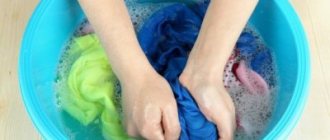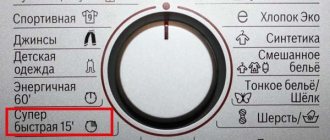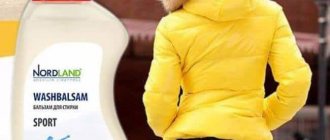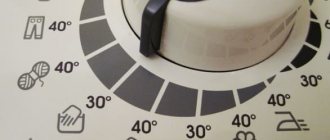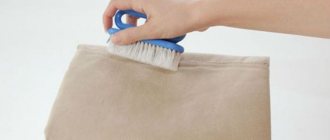Towels are home textiles that are used very intensively. Frequent use requires frequent washing.
In order for towels to serve and retain their attractiveness for a long time, they need to be properly washed, bleached, ironed, and dried.
Hand and machine washing of these products has its own characteristics, and they must be taken into account.
How to wash towels correctly, what to soak very dirty items in, how to bleach, do you need to iron after washing? Find answers to your questions in the article.
Preparing for the process: step-by-step instructions and how often to wash
A lot depends on the proper preparation of towels. Keeping these items looking good depends on how often they are washed.
Dermatologists recommend the following frequency:
- bath towels – after three times of use;
- kitchen towels - daily;
- towels for face and hands – 1-2 days.
Before washing, towels are sorted by fabric type and color. Infants' linen must be washed separately from adult towels. Colored and white products do not need to be placed in the same drum.
Very dirty products are first removed from grease and other inclusions . You can use the washing machine's capabilities by selecting the pre-soak mode, or soak the towels in a separate container.
The next step is to select the washing, rinsing and spinning mode. Next comes loading the washing machine drum. Despite the volume declared by the manufacturers, you should not load the washing machine to the maximum.
To maintain fabric quality, it is optimal to use 80% of the drum volume . That is, if this volume is 5 kg, it is better to load 4 kg of laundry.
It is possible that washing embroidered items decorated with lace and silk ribbons will require the use of a special laundry bag.
Items with metal or plastic fittings must not be loaded into the machine drum in which towels are washed.
Basic Rules
In order for the item to last as long as possible, you need to follow a few simple rules:
The drum of the washing machine must be 2/3 full for washing to be practical - this saves water, electricity, and the machine itself. Therefore, you will not be able to wash only towels at a time - throw them along with bed linen or other things. Linen should always be sorted by color - in no case should you wash white with dark or colored and vice versa. Do not store dirty items in a damp state and/or in the machine drum, as this may cause a musty smell and mold.
Buy a special basket - the laundry will “breathe” in it. Sort things not only by color, but also by type of fabric - labels will help you with this. If there are stains on the towels, use a stain remover. If your towels have any decorative details, it is better to wash them in a special bag. Well, the most important rule: pay attention to the label, it will always help you and tell you how to wash the item correctly so as not to spoil it.
In the washing machine
In times of advanced technology, not a single housewife can imagine her life without a washing machine. This is not surprising - it saves women’s energy and time, allows them to do household chores at the same time as washing, improves the quality of washing and allows children and men to be involved in helping around the house, because everyone can throw things into the drum! But you need to remember a few rules so that machine washing brings only joy.
Mode and temperature
Pay attention to the label that is sewn to the towel - usually it has recommendations on the mode and temperature, but if there are none, then you need to understand what material your item is made of:
- Terry and velor towels must be washed at low temperatures (30-40 degrees) on a delicate cycle. Be sure to include an extra rinse.
- Kitchen towels should be washed at 60 degrees on a cotton cycle to ensure they retain their ability to absorb moisture. Be sure to soak them before washing.
- Towels made of bamboo and modal are washed at 30 degrees, and towels made of linen and microfiber are washed at 40-60 degrees. Choose either manual mode or depending on the fabric (depending on what your machine allows).
Detergents
As mentioned above, when washing towels it is better to avoid dry powders. Replace them with liquid or special capsules.
Select detergents depending on the color of the fabric - this will help keep the color of the towels for as long as possible.
Spin
The spin power should be no higher than 500 rpm. During delicate washing, the spin cycle is turned on as quietly as possible, but you can turn it off altogether.
Dry towels only in the fresh air, as this will prevent them from drying out. But not in the sun - this will make them hard.
Manually
There are times when there is nothing to throw towels into the machine or it is completely broken. How then to wash towels?
- First of all, soak them in a soapy (not hot!) or vinegar (there is a recipe above) solution. This will make the towels softer, and stains (if any) will then be easier to wash off.
- If there are stains, rub them with stain remover and let the item sit for as long as it is written in the instructions for the product. Just remember that stain removers with chlorine should not be used for colored and dark fabrics.
- Now you need to move on to the main stage of washing - carefully “massage” the towel in a basin with a suitable detergent. If necessary, add salt to the water - this will make it “softer”.
- At the end you need to rinse the towel. The first time this can be done in salted water (for softness), and the second and third time in regular water. You cannot rinse the towel less than three times.
- Do not wring out the towel too much, just “squeeze” it lightly and take it out to dry in the fresh air.
That's all. As you can see, washing towels is not at all difficult, the main thing is to remember a few nuances so that they last as long as possible. Good luck!
In an automatic washing machine: on what mode, at what temperature?
Kitchen and bath towels are most often made from different fabrics. Therefore, they should be washed in different modes. How to choose the right program and at what degrees to wash?
Washing terry, bamboo and velor bath towels - optimal parameters:
bamboo and modal fiber – temperature 30-40 degrees;- cotton, linen, microfiber – 40-60 degrees;
- velor – 40 degrees;
- liquid detergent is used;
- spin mode – 800 rpm.
Washing kitchen towels:
- colored products - 40 degrees;
- white towels – 60 degrees;
- spin mode – 800-1000 rpm;
- washing mode – “cotton”;
- All-purpose detergent is used.
To choose the optimal detergent, you need to remember that the wrong dosage of washing powder will lead to it settling on the surface of the towel. Allergies, hard hair, unpleasant odor - these are just a few of the consequences of such a mistake.
It is best to choose a liquid or gel detergent for washing face and body towels. The most popular brands are Laska, Tide, Ariel, Dreft, Frosh, Myth.
Children's clothes are washed with specially selected products:
- Eared nanny,
- Our mother,
- Cotico,
- Sonett,
- Sodasan,
- Umka.
Frequent use of fabric softener when washing terry towels will deteriorate its absorbent properties.
How to wash it correctly so that it is soft and fluffy?
Let's consider what to do to keep terry products soft after washing. First of all, you need to comply with the washing conditions. Here are some general rules for what you need to do to prevent the towel from becoming stiff:
- Dry it before putting it in the wash.
- Avoid washing towels with items that have zippers or other metal inserts. This may damage the lint.
- Before drying, shake it to straighten the product.
- Do not dry the product near radiators, heaters or other heat sources.
These are the basic rules that are common for both hand and machine washing.
How to do this in an automatic washing machine?
How to wash a towel in an automatic machine to soften the product? To ensure that the cleaning process in the washing machine does not lead to damage to the product, it is enough:
- Wash products with liquid powders or liquid laundry soap. They are washed out of the pile better than powder particles. Try to choose products that do not contain chlorine and phosphates. If you still decide to wash your towels with a simple powder, use a second rinse.
- Add 9% vinegar to the conditioner compartment. It will protect the terry from hardness.
- Do not wash terry towels at temperatures above 40 degrees. High temperatures harm terry products.
- Do not fill the washing machine drum completely. This will make it easier for water to wash away any remaining detergent.
- For spinning, select a mode of no more than 400 rpm.
- Use a “massager” for terry products. It looks like a small ball with spikes and is sold in household chemical stores. It will fluff up the terry while washing.
- Choose a conditioner that contains silicone.
- Follow the instructions on the label.
- Add salt to the washing compartment. If possible, sea. Salt will soften the product.
- Add baking soda during washing. Add a teaspoon of soda to the laundry detergent; it will help keep the product soft, cope well with stains and soften the water.
- Do not wash terry textiles using the water saving mode.
Manually at home
The rules for hand washing are slightly different:
- Avoid powder; it is better to use liquid detergent, or, the old fashioned way, wash with laundry soap.
- Soak towels in cold water before washing.
- Dilute the detergent in warm water and add baking soda or salt. Soak it in the solution for 30-40 minutes.
- Wash the towel carefully, without sudden movements; do not rub or tug - this will damage the product.
- Rinse the product in 5 waters, add a little 9% vinegar to the last one.
How to do it manually?
To properly wash towels by hand, you need to prepare a washing container, liquid detergent, salt and vinegar.
Step-by-step instructions for hand washing:
Fill a deep basin or bathtub with warm water, add detergent to it until foam appears.- Soften the water with vinegar - a glass (200 ml) per bucket of water.
- Soak the towels for 40 minutes.
- Wring out and rinse the products, changing the water several times.
- Fill a basin with warm water, dissolve 2-4 tablespoons of salt in it.
- Rinse the towel in this solution to make it soft.
- We squeeze it out.
- We hang a towel to dry on the loggia, on the balcony, in the fresh air.
When drying towels indoors, make sure it is well ventilated.
Essential oil of lemon, lavender, tangerine, added when rinsing, will give the towels a pleasant aroma.
How to restore softness to terry towels
If excessive use of washing powder has caused the terry item to become rough, you just need to rinse it thoroughly. It is best not to do this in the washing machine.
Soak the item in cold water overnight. Then rinse, squeeze lightly and hang to dry. The remaining chemicals will be washed out of the villi and they will become fluffy again.
Salt and ammonia
The products help restore the softness of the fabric. It is enough to pour 3 tbsp. table salt into a bowl of lukewarm water and soak the towel for half an hour. Further washing should be done using special substances intended for delicate fabrics.
In tandem with ammonia, the effect of salt is more effective. The mixture will restore the saturation of colors, rid white items of grayness and yellowness, as well as old stains.
Even if you follow all the rules, after a while it will become tough, there is no way to avoid it. After this, I just want to replace it with a new one. But how long will another bath towel last? But don’t rush, maybe you can still give the old one the proper look, you just need to know what to do.
Under no circumstances should you boil a bath towel. After this procedure it will become even tougher. Do not wash such items in the “water saving” mode.
In order for towels to remain in their original form for a long time, it is necessary not only to wash them correctly, but also to store them. Washed towels do not need to be wringed excessively! If you did not use salt during washing, then soak the terry product in salted water for 20 minutes, then rinse thoroughly again.
Towels need to be dried unrolled, preferably in a ventilated place, but not under the direct sun. Dry only naturally, away from heaters. Bath towels do not need to be ironed.
A few tips to help keep your towels in their original condition:
- Use only liquid detergents for washing, and add salt, acetic acid or soda. Remember about emollients! Buy laundry detergents that do not contain phosphates. When choosing a rinse aid, give preference to products with silicone, thanks to which the product retains its “fluffiness”.
- Always re-rinse items to ensure no detergent remains on the fabric. If you wash by hand, then three rinses will be enough.
- Do not dry items in your apartment if your air is dry. This material needs moist air. It is recommended to hang products horizontally, because in a vertical position they can stretch.
- It is not recommended to set temperatures above 40 degrees during washing.
- Don't squeeze too hard!
- When washing, do not fill the machine with things; at least a third of the drum should be empty. In order to fluff up the pile of the towels a little, you can add tennis balls.
However, this will not be possible on the first try. You will have to wash the towels in warm salted water at least three times, pre-soaking them. The principle of soaking is similar to that described in the manual for hand washing.
Old towels can be restored not only to their softness, but also to their color. It is no secret that a large number of washes significantly reduces the brightness and intensity of colors.
It may seem that caring for terry products is full of difficulties and hassle. But in fact, each procedure from the list of manipulations takes no more than a couple of minutes.
Use these tips and soon you will get used to following simple rules, while enjoying the unusually softness of your terry towels and robes, which will serve you in the household for a long time.
A collection of folk recipes and remedies
Long-standing traditions of keeping the house clean have sorted out the most effective ways to wash towels.
With vegetable oil
It is carried out in very hot water, practically boiling water.
Products made from linen or cotton fabrics are poured with boiling water in which are dissolved:
- ½ cup soda;
- 1 tbsp. a spoonful of powder or liquid laundry detergent;
- 50 ml vegetable oil;
- 50 ml of any bleach.
After this “cocktail” has cooled, the towels should be rinsed thoroughly. Read more about this washing method here.
In the microwave
For such a wash, you need to prepare a durable plastic bag, laundry soap and stain remover.
Two or three towels should be moistened with water and soaped with soap. You can treat stains with dishwashing detergent or stain remover. There is no need to tie the bag.
processing mode :
- time – 90 seconds;
- power – 450-500.
If the towels become hot, then the process was successful. If not, then the procedure is repeated. This is followed by rinsing by hand or in a washing machine.
You can learn more about washing towels in the microwave from this article.
With vinegar
Washing with table or apple cider vinegar will preserve the brightness of the fabric's color, remove bacterial contamination and odor, and add softness and tenderness to rough terry towels.
To do this, just pour 1-2 glasses into the conditioner compartment or directly into the drum of the washing machine.
Pre-soaking towels in a vinegar solution (500 ml per 5 liters of water) will remove old stains.
With boiling
To wash using this method, you need a large container in which to boil the laundry.
To increase the effect, add to the water:
- washing powder or laundry soap (2 tbsp per 1 liter of water);
- soda ash;
- silicate glue (1 tbsp);
- hydrogen peroxide (4 tablespoons), plus ammonia (1 tablespoon).
The process lasts 15-20 minutes, then the towels must be removed from the boiling water with all precautions and rinsed. It is advisable to dry them in the fresh air to remove the smell of soap.
It is better not to boil colored towels to avoid loss of brightness.
With mustard powder and boric acid
Mustard powder is dissolved in hot water to a paste consistency . It is applied to damp towels and left for 7-8 hours.
Next, the items are washed, rinsed and dried as usual. To prevent the mustard mixture from drying out, you can leave the towels in a plastic bag.
Boric acid will give cleanliness and freshness to terry or cotton products . dense structure To do this, they are immersed in an acid solution (2 tablespoons per 4-5 liters of water) and left there for 2-3 hours.
This is followed by normal washing, rinsing and drying.
Rules for caring for dark-colored products
Before washing dark clothes in an automatic machine, you should consider the following simple recommendations:
The first thing you need to pay attention to is the label sewn to the wrong side of the garment. It contains all the necessary information regarding the care of the product: what to wash, in what mode, how to iron. Take forgotten small things out of your pockets - paper napkins, hairpins, keys
Such objects can damage clothes made from delicate fabrics. Black clothes are always washed inside out. This measure allows you to preserve the brightness of the color for a long time. Wash dark items at a temperature of thirty to forty degrees. In hot water, black and colored items inevitably lose their color pigments. You should not load the washing machine drum to the limit, otherwise you will not be able to rinse the fabric thoroughly, especially when using regular washing powder.
Selecting a detergent
Experts do not recommend using traditional laundry detergent to wash dark clothes. It is better to purchase a specialized liquid detergent for washing black clothes so that they do not lose color. In addition, such household chemicals are more gentle on delicate fabrics and are also quickly washed out of the fibers. Below is a rating of the best detergents for washing dark clothes:
- The gel is intended not only for washing black clothes, but also any clothes of dark colors. In addition, Sarma allows you to effectively remove various contaminants, even from delicate products. After washing, there are no streaks or pellets left on the fabrics.
- Burti Noir. Liquid detergent can remove even stubborn stains on dark fabrics, and can also restore black items to their original brightness.
- Gel-like detergent for washing black laundry is designed to wash such items both manually and in a washing machine. The Yplon formula contains cashmere extract, which is designed to restore dark items that have lost their color saturation.
- Weasel is the radiance of black. Helps effectively remove white stains from black clothes. If you regularly wash dark clothes with Laska, after two to three weeks you will be able to completely restore the color.
- Blitz Black. This gel can be used to wash dark items even from delicate fabrics. Copes well with various stains and stains. Prevents limescale from settling on the internal elements of the washing machine.
Expert opinion
Evgenia Taran
Housewife
It is worth noting that in order for black clothes to always look perfect, they should be washed with similar household chemicals immediately from the moment of purchasing a new item. Also, when using store-bought products, you must strictly follow the instructions for use.
We recommend: How to restore whiteness to white things
Getting rid of stains
Before washing black linen or clothes, you will need to get rid of stains on things. Let's look at the best ways to remove stains of various origins from dark fabrics:
On black things, white stains most often signal careless use of antiperspirant. To remove sweat stains under the arms, you will need to dissolve five grams of table salt and ammonia in a glass of water.
Then apply the resulting product to the stained area. After fifteen minutes, wash the clothes in any suitable way. Any dishwashing gel will help remove greasy stains. The method of application is simple - just apply a few drops of the product to a moistened, dirty area and vigorously rub it. Table salt will help remove sweat stains. To carry out the hygienic procedure, you will need to prepare a special mixture of equal amounts of vodka and ammonia. Then, treat the stained areas. If you need to remove sweat stains from woolen items, you need to apply a strong saline solution to them. You can clean dark polyester from oily stains using regular laundry soap. You need to remove stains moving from the periphery to the center. Fresh blood stains should be removed with clean cold water. If blood stains have already dried, to enhance the cleaning effect, wash the dirty fabric with dishwashing detergent. If stains remain on the fabric after washing in rusty water, a weak vinegar solution will help to cope with this problem. To prepare it, you need to mix a liter of clean water and twenty milliliters. This mixture should be applied to the area contaminated with rust and vigorously rubbed.
How to make fabric soft?
Reasons for deterioration in the quality of towels:
- hardness of water;
- use of low-quality washing powders;
- incorrectly selected washing mode - high temperature, insufficient rinsing, intensive spin;
- boiling towels, ironing instead of steaming.
To soften the water when rinsing towels, use table vinegar in a proportion of 100-200 ml per 10 liters of water. When machine washing, vinegar is poured into the conditioner compartment.
How to ensure that soft and fluffy towels never become hard:
- Wash with liquid detergents without chlorine and phosphates.
- Use the quick wash mode more often for minimal impact on the fabric.
- Use an extra rinse.
- Bleaching terry cloth is absolutely necessary.
- Soften hard water.
Why do towels become stiff after washing?
Every woman has at least once encountered a situation where terry towels become hard after washing.
Why is this happening? The reason for this is the mistakes of housewives in caring for terry clothes. Such textiles require a special attitude, which includes three stages:
- careful use of terry and proper handling of it;
- gentle wash;
- gentle drying of clothes.
We will consider the rules for each stage separately, thanks to which we will be able to preserve the original appearance of textiles, even after using them for a long time.
Errors in handling terry bath towels may be as follows:
- Wrong washing mode. It is not recommended to fill the machine drum completely, as this will cause the laundry to be poorly rinsed. Using the economy mode on a machine with a small amount of water also reduces the quality of the wash. Too hot water significantly affects the quality of the terry. Spinning at high speeds also adds harm.
- Unsuitable detergent. The use of powders has a detrimental effect on soft tissues, drying them out.
- Hard water. This is a big problem in all regions where there is a central water supply. Such water contains lime salt in excess, which penetrates into the fibers of fabrics and makes them rough.
- Boiling. Another way to ruin your favorite towels is with boiling water. This is another method of our grandmothers, which is now irrelevant.
- Ironing without steaming. Again, high temperatures are to blame. In this case, the situation is saved by turning on the steam mode on the iron. But it's better to avoid ironing.
Getting rid of the smell
Possible reasons:
- incorrectly selected washing and drying mode:
- long-term use of kitchen towels,
- insufficient ventilation of the bathroom,
- high humidity in the room for drying products.
To get rid of odor on towels, soak them for 8-10 hours in a solution of baking soda and vinegar. The ingredients are mixed in a 1:1 ratio (a glass of vinegar to a glass of soda), after which the washing is carried out as usual.
Terry towels are machine washed using a similar solution. You don’t have to add washing powder, use an extra spin.
If the above remedies are ineffective, Oxiclean will come to the rescue . Three-quarters of a glass of detergent is dissolved in hot water and the foul-smelling towels are left for 1-2 days.
Method 13. For coffee stains - 2
- a fresh greasy stain can be easily removed by any dishwashing detergent. Apply this product thickly to the area of contamination and leave for 3-4 hours. Then wash as usual and rinse.
- Laundry soap is suitable for removing old grease stains. The dirty place is lathered thickly. The towel is rolled up so that the stain is inside. You can put it in a bag. Leave it for a day.
- If mold appears on the towel under prolonged exposure to moisture, 9% vinegar will help remove it. Dilute 2 tablespoons of vinegar in three liters of water. Soak the product for 10-15 minutes.
When removing heavily soiled areas, cleansers should be applied only to the stain.
It happens that it is not possible to put the towel in order in one go. The update procedure can be repeated 1-2 times.
If the result is not satisfactory, then most likely the product has expired. It is worth updating the towels and washing them according to the above rules.
If the spots are already a week old, then they can be called old. It is much more difficult to bring them out than fresh newcomers. But for such a task there is a proven and not at all complicated method:
- dilute citric acid or hydrogen peroxide in warm water;
- moisten the stains with the solution and leave for a couple of hours;
- then soak in warm water with powder for half an hour;
- wash as usual.
Yes, the method turns out to be rich in action, but it will get rid of even the most old and greasy stains.
Coffee stains are some of the most difficult stains to remove. Ammonia can handle them:
- it must be mixed with water in proportions of one to one;
- then apply the solution to the stain;
- stand for an hour;
- soak the towel in warm water with powder for 15–20 minutes;
- wash in the usual way.
It is advisable to work with ammonia in a well-ventilated area.
There is another recipe based on ammonia. Let's get rid of coffee and tea stains again. To do this you need:
- mix glycerin with ammonia in proportions 4:1;
- add the resulting mixture to a liter of warm water;
- soak towels for two hours;
- wash as usual.
Preserving the tenderness of terry products
What can you do to ensure that terry towels retain their pristine softness for a long time? Recommendations depend on the washing method.
For washing machine:
- wash in soft water;
- use delicate mode, temperature not higher than 60; spin mode does not exceed 500 rpm;
- to prevent terry fibers from being wrinkled, you need to put special balls in the drum of the washing machine;
- air dry, iron with a steam generator.
Before hand washing, towels are soaked in a warm detergent solution. At least 2-3 rinses are required to completely remove the detergent.
If the towel has already become hard, soak it in salt water (4 tablespoons per 10 liters) before hand washing.
You can learn how to properly wash washed terry towels here.
Method 4. How to boil kitchen towels - basic instructions
Boiling can help if you don't have a washing machine at home or if your towels seem so dirty that it's easier to throw them away than try to wash them.
Important! Colored kitchen towels should not be boiled.
- Fill a large saucepan/basin/metal bucket about 2/3 full with water. Add washing powder/bleach/stain remover/other detergent to it at the rate of: 2 tablespoons of detergent per 1 liter of water (unless otherwise indicated in the product instructions).
- Place a bowl over medium heat, add towels and bring the solution to a boil. Try to stir the contents of the basin as often as possible.
- When the solution boils, reduce the heat to low and continue to cook the kitchen towels for 15 minutes to 2 hours, depending on the degree of soiling and the color of the fabric. It is better to boil colored towels for no more than 15-20 minutes; light-colored towels should be left longer. Do not forget to constantly stir the contents of the basin.
- Now that the towels have boiled, transfer them to an empty bowl using tongs and leave to cool.
- Wring out the cooled items thoroughly and rinse as usual.
Adviсe:
Before boiling with bleach, it is advisable to first wash your towels by hand or in a washing machine.
Washing powder can be replaced with a mixture of laundry soap (72%) and soda. Grate the soap on a medium grater at the rate of 2 tablespoons per 1 liter of water, pour the shavings into the water, then add soda at the rate of 1 tbsp. spoon per 1 liter of water. Next, boil the kitchen towels in this solution, following the basic instructions above. You can also use baking soda and soap separately.
What should you consider when washing kitchen towels?
To preserve the beauty of kitchen towels for a long time, you must follow the following rules:
textile towels of bright colors are washed at a temperature not exceeding 60- waffle towels in light shades will become clean when washed at a temperature of 90-100
- It is advisable to neutralize grease stains by pre-soaking them before putting towels in the washing machine;
- Ironing in the optimal mode is necessary to maintain the neatness and cleanliness of the fabric.
Disinfecting kitchen towels with ammonia, a solution of manganese or chlorine-containing substances if the dosage is incorrectly chosen destroys the fabric. It is advisable to have separate towels for hands and dishes.
Read more about washing kitchen towels here.
Reasons for hard towels
Let's start with the fact that making towels soft is not just an urgent problem that is solved differently in each individual family. The global scale is visible here. Let's take the tourism, sports and hotel businesses as examples. For hotel administrators, hotel managers, and directors who own sports complexes, it is important that their clients remain satisfied with the service provided.
Hygiene items must meet basic requirements.
The cleanliness and softness of the towels comes first.
Now let's determine why towels become hard.
First of all:
- Due to a disrupted washing process;
- Improper rinsing;
- Use of inappropriate auxiliary products (powders, gels);
- Due to washing in low quality water.
- Due to subsequent improper ironing.
Over time, the pile of terry fabric begins to settle, becoming denser and deformed, as a result of which the product loses its original fluffiness.
We take into account the features of microfiber products
This canvas has unique properties. Microfiber towels are light, soft, perfectly absorb moisture, and are wear-resistant. They can withstand up to 500 washes without losing their properties .
How to properly wash microfiber towels in a washing machine:
- optimal washing mode – delicate, at 40-60;
- for heavily soiled items, pre-soaking is used;
- Do not put faded items from other fabrics into the drum, as microfiber easily takes on the shades of dyed items;
- no need to use air conditioner;
- Microfiber towels should be dried outside the washing machine.
When washing very dirty towels by hand, pre-soak them in a soap solution, intensively lathering particularly dirty areas. You can apply a paste of baking soda to the stains.
Towels are rinsed in water with the addition of citric acid or natural juice. Do not bleach these towels.
Bamboo fiber towels
These products have become very popular in recent times due to their many wonderful qualities. Among their advantages:
- Bamboo is an excellent natural antibacterial agent that suppresses pathogenic microflora. It is also hypoallergenic: the best option for those who have children and adults in the family who suffer from allergies, skin inflammation, fungus and other dermatological diseases.
- Bamboo towels are very soft and delicate, they instantly absorb moisture and quickly evaporate it.
- Bamboo towels can easily withstand repeated washing (sometimes up to 500 cycles!). They do not lose color, shape and softness.
- They wash well and dry quickly. Retains freshness for a long time between washes due to high breathability.
How to properly care
Bamboo towels do not require special care. It is enough to follow the instructions on the product label: it is better to wash them by hand with ordinary powder or soap. If you do machine wash, use the gentle cycle. The water should be warm (no more than 30 degrees). Do not use softeners or bleaches; spin at low speed.
Tip: The appearance of individual threads on a towel after washing is normal. They just need to be carefully cut off.
Whitening - gentle and effective
Typically, bleaching is carried out during the washing process, when bleach is loaded into a special section of the machine. If hand washing is planned, the product is used in accordance with the instructions.
Types of bleaches:
optical (Belofor, Persol, Dimerax) – whitening occurs due to the sedimentation of microparticles of the product on the fabric fibers;- oxygen (Swan, White without chlorine, Tadox, Vanish) - do not damage fabric, are effective when bleaching in slightly warm or cool water;
- chlorine-containing (Chlorin, Domestos, Belizna, AC) - used for bleaching cotton or linen towels.
One of the most effective methods of whitening towels is to soak them in a solution of 72% laundry soap. It needs to be rubbed and filled with hot water until it dissolves and produces foam.
Products made from terry cloth, linen, and cotton are kept in this solution for about an hour. Next comes hand or machine wash and rinse. The above method not only whitens, but also softens towels.
Another affordable and cheap whitening product is hydrogen peroxide. Sequence of use:
- Dissolve 2 tablespoons of peroxide in 5 liters of water.
- Place the towels in the solution for 40-50 minutes, stirring them from time to time.
- Rinse the items and hang them to dry.
Hydrogen peroxide can be replaced with hydroperite tablets. Two tablespoons of the product can be replaced with 4-5 tablets.
Whitening methods
If home textiles have become stiff and have acquired a grayish tint, you should avoid using special bleaching detergents. To return the original whiteness, the product must be soaked in a water-salt solution: add a tablespoon of salt and a teaspoon of ammonia to 2 liters of water. Towels are left in this water for at least 8 hours. Afterwards you can start washing as usual.
If this method does not help remove stubborn stains, you can use simple laundry soap for washing. The stain needs to be thoroughly soaped, then carefully roll the towel into a tube, put it in a plastic bag and put it in the microwave for a couple of minutes. After this treatment, the stains are guaranteed to disappear. All that remains to be done is to rinse the towels properly. This method is very effective. It will help remove not only greasy stains, but also traces of natural food dyes, such as berries, coffee or fruit.
If you know how to properly wash and care for terry towels, the products will last for years. The most important thing is to avoid clogging, choose the appropriate washing mode (the water temperature should not exceed 40 degrees, and the spin intensity should vary within 600 rpm) and use liquid detergents.
Ironing - pros and cons
How many copies have been broken in the debate about whether to iron towels or not, but there is still no consensus. The terry pile of towels gets crushed when ironed and they become hard. The fabric loses its hygroscopicity, it absorbs moisture much worse.
Terry towels need to be hung carefully after washing and folded just as carefully after drying . An exception can be made when ironing terry towels for young infants. Here, ironing disinfects the fabric, killing any possible bacteria on the linen.
Linen and cotton kitchen towels are ironed right side out. Embroidered kitchen utensils are steamed or ironed from the inside out.
Thin microfiber cannot be ironed , as synthetic fibers are destroyed by the action of a hot iron.
You will find maximum useful information about washing clothes and various fabric products here.
In addition, towels become stiff due to...
- Low-quality cheap washing powder , which is difficult to rinse out of fabric fibers. Phosphate-based powders spoil terry towels especially quickly.
- Increased water hardness . The more calcium and magnesium in the water, the faster the terry towel becomes unusable.
- Incorrect washing mode . Usually, softness disappears when the temperature is set incorrectly (too high) and the spin power is high.
- Too dry air . At low humidity (approx. - below 20 percent), towels dry out and lose their fluffiness.
- Regular ironing. Alas, ironing terry towels in the classic way is not recommended.
- Low quality fabric. The lower the quality, the faster the towel loses its attractiveness.
Expert recommendations
The rigidity of terry towels is not a death sentence or a reason for their disposal. At least until methods have been tried that make it easy to restore the former softness of these things. Moreover, it is not necessary to purchase any additional and expensive preparations to restore the fluffiness of bath products.
Everything you need is available in any home. In addition, part of the process of returning the pile of your favorite towels to the resemblance to chicken down does not even involve the use of any mandatory products.
Additional tips:
- When choosing soda ash, they prefer regular baking soda. Because the first one can cause irritation on the skin.
- Well-treated towels, dried in the fresh air, have their own pleasant smell of impeccable cleanliness. If you want to give them an additional aroma, instead of using a perfumed mouthwash, use empty bottles of your favorite perfume, bars of dry toilet soap, and sachets with aromatic herbs.
Even with little experience in housekeeping, you should not be discouraged if it turns out that terry towels are no longer as pleasant to the touch as before. This incident is common and can happen to anyone. Fortunately, the fix is quite simple. The main thing, as they say, is desire. Well, a little understanding of the essence of the problem.
Video
Rating of washing powders
Which product cleans best? You have 2 votes.
Baby washing powder
2
42
Washing powder
It is only inexperienced housewives who think that there is no difference between the result of washing with the addition of a granular substance to the water and the use of gel. As practice shows, the final effect varies. And the more sophisticated the manufacturer of the hygienic “sand” is with the composition of the powder, the worse it is for the user’s things. And a lot depends on the water: the harder it is, the worse the result after washing terry towels.
In addition, substances from the powder penetrate deeply into the fibers of fabrics and not only wash out everything that is possible from them, but also actively replace them with themselves, not rushing to leave the vacant places that appear even when rinsing. Why, if there is not enough water at the final stages of washing, the pile of soft towels just yesterday turns into a kind of bristles. Because it is impregnated with additions invisible to the naked eye.
Structure of a terry towel
Proper drying
Cotton, bamboo and any other natural materials lose their inherent softness when exposed to direct sunlight and heat from radiators. Therefore, without a properly organized process of drying washed bath accessories, they quickly turn from objects that caress the skin into ones that harden it through not the most gentle influence.
Expert opinion
Irina. Housewife.
Still, a hard massage, for example, with a linen mitten, is indicated before taking a shower or bath. But not after that.
This is interesting: How to wash jeans in an automatic machine: choosing a product, tips for removing stains
The following rules for washing and drying towels will help maintain fluffiness:
- We use only soft gel products for washing terry towels , and be sure to add a softening agent - salt, soda or vinegar. Don't forget about water softeners! We buy detergent without sophosphate and without chlorine in the composition. When choosing a conditioner, pay attention to a product with silicone, which helps maintain the fluffiness of towels.
- We always turn on an extra rinse so that not a trace of detergent remains in the fabric. For manual rinsing, change the water 3-4 times.
- We do not dry towels in rooms with dry air - this fabric needs high humidity when drying! It is recommended to hang it to dry horizontally.
- Towel washing mode : set the temperature to no more than 40 degrees.
- Spin speed – no more than 400 rpm. When manually squeezing, don’t get carried away!
- We do not push towels into the drum - we leave 1/3 of the space of the drum free from things. And add tennis balls before washing to “fluff up the lint.”
How to determine water hardness
It is no secret that towels become hard not only because the washing and rinsing process is disrupted or inappropriate products are used, but also because low-quality water is used for washing.
To keep your new towels as long as possible, learn how to care for them correctly, taking into account the structure of the fabric.
The quality of the water composition plays an important role. Hard water can have a negative effect on the material. Therefore, before washing, it is better to clarify its condition in order to then correct the situation.
Terry textiles are capricious and need special treatment.
There are simple home methods to help determine water hardness.
- Many housewives use regular tea for these purposes. Brew loose leaf tea, infuse it and observe the shade. The fact that hardness is present will be established if it is dark and shows turbidity. Soft water in tea will reflect the peach color.
- Detergents also have the ability to determine water hardness. How to do it? In the usual way. Just soaping your hands. Does soap create foam quickly? This means that the salt level is minimal. If, on the contrary, foaming occurs for too long, then the quality of the water composition is poor.
Use liquid detergents for delicate washing - this will preserve the lushness of the fabric.


